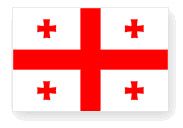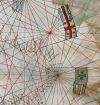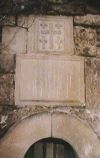
 For Georgian historiography, several written sources are known, giving reliable notifications about the State Flag of Georgia (about its color and usage) - "as they glanced back, they saw
For Georgian historiography, several written sources are known, giving reliable notifications about the State Flag of Georgia (about its color and usage) - "as they glanced back, they saw the king [David Soslan] and his army near him and a flag (Gorgasliani) of King Vakhtang Gorgasali flying as entering Sindhi..." (The Georgian Chronicles). "[King Tamar] took a flag of Vakhtang Gorgasali and David the Builder (Gorgasliani, Davitiani) used successfully and begged Vardzia Mother of God for the flag and blessed the army and sent it to Persia." (The Georgian Chronicles). According to 13th century chronicler, Stephanoz Orbeliani, "this was established that the king should carry a white flag with a red mark." In order to ascertain a "name" of the flag, notification of a poet of 12th-13th centuries, Ioane Shavteli is also interesting: "encouraging its army, the flag of Vakhtang Gorgasali and David the Builder (Gorgasliani-Davitiani) was carried as a destroyer of the enemy."
the king [David Soslan] and his army near him and a flag (Gorgasliani) of King Vakhtang Gorgasali flying as entering Sindhi..." (The Georgian Chronicles). "[King Tamar] took a flag of Vakhtang Gorgasali and David the Builder (Gorgasliani, Davitiani) used successfully and begged Vardzia Mother of God for the flag and blessed the army and sent it to Persia." (The Georgian Chronicles). According to 13th century chronicler, Stephanoz Orbeliani, "this was established that the king should carry a white flag with a red mark." In order to ascertain a "name" of the flag, notification of a poet of 12th-13th centuries, Ioane Shavteli is also interesting: "encouraging its army, the flag of Vakhtang Gorgasali and David the Builder (Gorgasliani-Davitiani) was carried as a destroyer of the enemy."
Based on these notifications and comparatively later visual sources, the Gorgasliani-Davitiani flag took the shape, which it has today in 1320, when King George V the Brilliant (1314-1346) got "the locks of Jerusalem" after sending ambassadors to Sultan of Egypt. Since this time, a five-mark composition personifying Jesus Christ and heralds (with different varieties, including depicting five crosses) has been presented as a symbol of Georgia, which is confirmed by a lot of marine maps-portulans, on which a five-mark composition is depicted (on portulans) at the tops of fortresses of Tbilisi and Tskhumi (Sokhumi).
We present a small list of ancient historical marine maps:
A 1318 map of Pietro Vesconte (approx. 1310-1330), which was published in 1321 by Venetian statesman and geographer, Marino Sanudo senior, in the addition (continuation) of his book, Liber Secretorum, written approximately in 1307, Opus Terrae Sanctae. This is protected at the Royal Library of Great Britain (Pietro Vesconte is considered as a founder of portulan diagrams).  1339 portulan of Angelino Dulcert. Protected at the Royal Library of Great Britain.
1339 portulan of Angelino Dulcert. Protected at the Royal Library of Great Britain.
1367 portulan of Francesco and Domenico Pizigano. Protected at Biblioteca Palatina in Parma. 
1439 portulan of Gabriel Vallseca (approx. 1408-1467). Protected at National Library of Catalonia.
We frequently meet analogical images of five-cross composition of the State Flag of Georgia (symbolic image of Jesus Christ and four heralds) in different shapes in bas-reliefs of Georgian churches and genre art-figurative culture of the middle ages. They are presented on Nekresi church (6th century), Bochorma (10th century), Chkeri (15th century) churches, as well as on a silver coin of David III Kuropalates (10th century), Georgian ornaments, ethnographic samples (Khevsurian carpets; Talavari (Khevsurian clothes)), etc.
State council of heraldry
at the Parliament of Georgia










